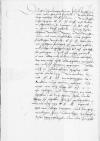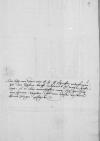Uns ist jesstrigs thages E(wer) F(urstlichen) D(urchlauch)t cf. Albrecht I von Hohenzollern-Ansbach to Ioannes DANTISCUS Königsberg, 1539-04-19, CIDTC IDL 4950⌊briffcf. Albrecht I von Hohenzollern-Ansbach to Ioannes DANTISCUS Königsberg, 1539-04-19, CIDTC IDL 4950⌋ / und dorbeÿ ir schreÿbenn in copeÿen an Sigismund I Jagiellon (Zygmunt I) (*1467 – †1548), King of Poland and Grand Duke of Lithuania (1506-1548); Duke of Głogów (Glogau) (1499-1506), Duke of Opava (1501-1506), Governor of Silesia (1504-1506); son of King Kazimierz IV Jagiellon and Elisabeth of Austria⌊ko(niglich)e m(aieste)tSigismund I Jagiellon (Zygmunt I) (*1467 – †1548), King of Poland and Grand Duke of Lithuania (1506-1548); Duke of Głogów (Glogau) (1499-1506), Duke of Opava (1501-1506), Governor of Silesia (1504-1506); son of King Kazimierz IV Jagiellon and Elisabeth of Austria⌋, u(nsern) a(llergnedigsten) hern, negst gestaldt, / durch dÿsen bothenn worden, / worÿnne wir vornhomen, / mit was sorgfeldikeit / aus hochem furstlichen vorstandt / E(wer) F(urstliche) D(urchlauch)t diser sweren tzeÿthenn ferlicheit zu gemuet gefurt, / und solchs an hochgedachte ko(niglich)e m(aieste)t hat lasssen gelangen. / Und yst nichts gewest, / so wir alles midt sondrem vleis uberlesen, / das uns nicht hett allenthalben wolgefallen / und zu hertzenn gegangen. /
Wollen auch in zukunfftiger Provincial Diet of Royal Prussia ⌊thagfartProvincial Diet of Royal Prussia ⌋ all unser fordrung vorwenden, / domit E(wer) F(urstliche) D(urchlauch)t trawhertzigem bedenckenn muge werden gefolget, / dÿweÿl uns auch solchs Sigismund I Jagiellon (Zygmunt I) (*1467 – †1548), King of Poland and Grand Duke of Lithuania (1506-1548); Duke of Głogów (Glogau) (1499-1506), Duke of Opava (1501-1506), Governor of Silesia (1504-1506); son of King Kazimierz IV Jagiellon and Elisabeth of Austria⌊ko(niglich)e m(aieste)tSigismund I Jagiellon (Zygmunt I) (*1467 – †1548), King of Poland and Grand Duke of Lithuania (1506-1548); Duke of Głogów (Glogau) (1499-1506), Duke of Opava (1501-1506), Governor of Silesia (1504-1506); son of King Kazimierz IV Jagiellon and Elisabeth of Austria⌋, u(nser) a(llergnedigster) her, befolhen, / und derwegen ein bottschaffter an dÿ hernn Council of Royal Prussia the most important local authority in Royal Prussia. It consisted of two bishops (of Ermland (Warmia), who served as the Council’s president, and of Kulm (Chełmno)), three voivodes (of Kulm, Marienburg (Malbork), and Pomerania), three castellans (of Kulm, Elbing (Elbląg), and Gdańsk (Danzig)), three chamberlains (of Kulm, Marienburg, and Pomerania), and representatives of the three Great Prussian Cities – Gdańsk, Thorn (Toruń), and Elbing (ACHREMCZYK 2016, p. 17-18)⌊dÿser lande reteCouncil of Royal Prussia the most important local authority in Royal Prussia. It consisted of two bishops (of Ermland (Warmia), who served as the Council’s president, and of Kulm (Chełmno)), three voivodes (of Kulm, Marienburg (Malbork), and Pomerania), three castellans (of Kulm, Elbing (Elbląg), and Gdańsk (Danzig)), three chamberlains (of Kulm, Marienburg, and Pomerania), and representatives of the three Great Prussian Cities – Gdańsk, Thorn (Toruń), and Elbing (ACHREMCZYK 2016, p. 17-18)⌋ zu schicken hat zu cf. Sigismund I Jagiellon to Ioannes DANTISCUS Cracow, 1539-04-13, CIDTC IDL 2133⌊geschrÿbencf. Sigismund I Jagiellon to Ioannes DANTISCUS Cracow, 1539-04-13, CIDTC IDL 2133⌋. / Ferner auch, wÿ E(wer) F(urstliche) D(urchlauch)t begertt(en), / hab wir solche copeÿen / and den hochwirdigen hern Tiedemann Giese (Tidemannus Gisius) (*1480 – †1550), in 1519 ennobled by King Sigismund I; 1504-1538 Canon of Ermland (Warmia); 1516-1527, 1533-1537 Judicial Vicar and Vicar General of Ermland; 1523-1538 Custos of Ermland; 1537-1549 Bishop of Kulm (Chełmno); 1549-1550 Bishop of Ermland (BORAWSKA 1984, passim)⌊colmischen bÿschoffTiedemann Giese (Tidemannus Gisius) (*1480 – †1550), in 1519 ennobled by King Sigismund I; 1504-1538 Canon of Ermland (Warmia); 1516-1527, 1533-1537 Judicial Vicar and Vicar General of Ermland; 1523-1538 Custos of Ermland; 1537-1549 Bishop of Kulm (Chełmno); 1549-1550 Bishop of Ermland (BORAWSKA 1984, passim)⌋ etc. dÿsen thag cf. Ioannes DANTISCUS to Tiedemann GIESE Heilsberg (Lidzbark Warmiński), 1539-04-25, CIDTC IDL 2136⌊gefertigetcf. Ioannes DANTISCUS to Tiedemann GIESE Heilsberg (Lidzbark Warmiński), 1539-04-25, CIDTC IDL 2136⌋, / dem ane zweÿffel  GStA PK, HBA, C1, No. 567, f. 1v diss alles mit wirt gefallen, / dan E(wer) F(urstliche) D(urchlauch)t noch unserm vormugen(n) vÿl freuntlicher dinst und wÿllen zu thun, / sein wir alweg geflissen. /
GStA PK, HBA, C1, No. 567, f. 1v diss alles mit wirt gefallen, / dan E(wer) F(urstliche) D(urchlauch)t noch unserm vormugen(n) vÿl freuntlicher dinst und wÿllen zu thun, / sein wir alweg geflissen. /
 GStA PK, HBA, C1, No. 567, f. 2r
GStA PK, HBA, C1, No. 567, f. 2r
Der both, von dem wir E(wer) F(urstlichen) D(urchlauch)t schriffte entpfangen, / het wir dÿsenn briff widerumb zu tragen gefertiget. / So er aber unvorhoffter weis / sich heimlich von hinnen bogeben, / hab wir dÿsen unsern(n) kam(m)er jungen geschickt etc.
 GStA PK, HBA, C1, No. 567, f. 3v
GStA PK, HBA, C1, No. 567, f. 3v  GStA PK, HBA, C1, No. 567, f. 1r
GStA PK, HBA, C1, No. 567, f. 1r  GStA PK, HBA, C1, No. 567, f. 1v diss alles mit wirt gefallen, / dan E(wer) F(urstliche) D(urchlauch)t noch unserm vormugen(n) vÿl freuntlicher dinst und wÿllen zu thun, / sein wir alweg geflissen. /
GStA PK, HBA, C1, No. 567, f. 1v diss alles mit wirt gefallen, / dan E(wer) F(urstliche) D(urchlauch)t noch unserm vormugen(n) vÿl freuntlicher dinst und wÿllen zu thun, / sein wir alweg geflissen. /
 GStA PK, HBA, C1, No. 567, f. 2r
GStA PK, HBA, C1, No. 567, f. 2r 


